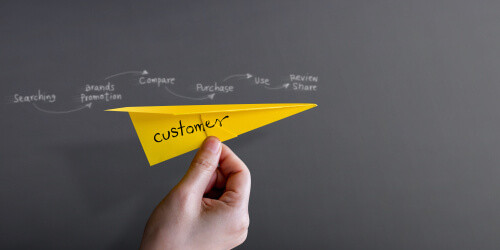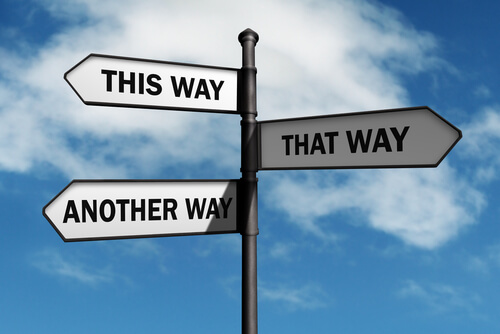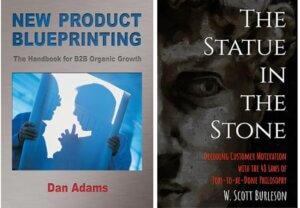Power your CX with Jobs-to-be-Done

Jobs-to-be-Done brings CLARITY and PRECISION to every element of innovation, product development and marketing. And likewise, there’s no better structure to understand CX, Customer Experience, than Jobs-to-be-Done. The problem with “Customer Experience” (CX) programs is that we’re missing common definitions of what CX is. Some think about customer journey maps. Some think about NPS surveys. Others think that a CX program means a formal program of customer visits.
Enter our hero, jobs-to-be-done (JTBD).
Granted, to some, jobs-to-be-done can sound theoretical and abstract. However, JTBD’s power comes from precision. This “abstractness” is only something that we react to initially, just as with learning any new topic for the first time.

What is Jobs-to-be-Done?
JTBD is a philosophy and methodology for creating customer value. It’s based on the metaphor that “a customer hires a product to accomplish a job.” This concept separates the product from the reason people buy it.
Products come and go, but our basic needs stay the same across the millennia. The customer’s job-to-be-done will be more stable than any product.
For more on jobs-to-be-done, read the AIM article “Jobsto-be-done: The Cure for B2B Myopia” or “The Statue in the Stone: Decoding Customer Motivation with the 48 Laws of Jobs-to-be-Done Philosophy.”
What is CX, or “Customer Experience?”
CX is a company’s program of continuous customer satisfaction improvement. Our initial issue with CX begins with this fuzzy definition. However, the primary elements can be organized into four typical buckets:
Customer Satisfaction or Customer Loyalty: Determining how satisfied customers are and how likely they are to recommend a company’s products or services. The most famous metric is the Net Promoter Score (NPS). Others include Customer Satisfaction Score (CSAT) and Customer Effort Score (CES.)
Customer Journey: Mapping the customer’s journey from purchase to acquisition, use, maintenance and disposal. This invokes images of teams putting sticky notes on a wall and treating the customer’s journey as a process.
Touchpoints: Monitoring and managing all customer “touchpoints” with a company. This includes website visits, social medial posts, customer service experiences, and elements of the customer journey.
Primary Research: Execution of qualitative research, primarily ethnographic work, where researchers visit customers in the context in which they use a product or service. For CX research, customers are given easy means to provide product feedback, such as with a diary or phone app.

Jobs-to-be-Done reveals “The Why”
To see how jobs-to-be-done dispels the mystery around CX, we need to look no further than how it removes the fuzziness from innovation. The good Dr. Clayton Christensen popularized JTBD in his famous case study with McDonald’s milkshakes. He worked with McDonald’s to help them to see the world through the lenses of their customers as he helped them to pursue a segment of customers who purchased milkshakes in the morning by understanding WHY they purchased the milkshake.
With an understanding of WHY the milkshake was purchased, McDonald’s could clearly see how to improve the product so that it could perform this function even better. In this case, the milkshake kept folks full for hours, was slow to consume, therefore provided relief from boredom, and could be easily consumed with a single hand while driving. The one flaw was that customers felt a bit guilty for drinking a milkshake for breakfast. To address this, they added bits of fruit and renamed the beverage a “smoothie.”
CX and Jobs-to-be-Done: The Job Map
In the years following Dr. Christensen’s advocacy for jobs-to-be-done, Tony Ulwick emerged as champion of an applied JTBD process dubbed ODI, or “Outcome-Driven Innovation.” Ulwick and Lance Bettencourt published “The Customer-Centered Innovation Map,” in Harvard Business Review, an article that remains one of the cornerstone references for jobs-to-be-done.
And it’s this article that provides the linkage to CX.
“The Customer-Centered Innovation Map,” which would soon be renamed the “The Job Map,” breaks a job down into various process steps. For example, if you want to understand the challenges that a customer has when, say, “Planning a vacation,” you break this job down into job steps, which are no more than smaller scoped jobs themselves. To plan a vacation, we may go through these steps:
- Evaluate destinations
- Determine destinations
- Obtain travel options to the destination
- Gain consensus amongst travelers for travel options
- Book travel to the destination
- Pay for travel
- Evaluate the travel plan
- Modify the travel plan
When we create a job map, we take something large and break it into smaller pieces for analysis. For customer experience, or for what we call “CX,” we take a similar trip but with the usage of a specific subtopic of jobs-to-be-done, consumption jobs.

Consumption Jobs: To go forward, you must go back
In George R.R. Martin’s book series “A Song of Ice and Fire,” the prophet Quaithe cryptically states, “To go forward, you must go back.” And to connect jobs-to-be-done with CX, we likewise must go back. Back to Ian MacMillan and Rita McGrath’s 1997 HBR article titled “Discovering New Points of Differentiation,” in which they described the entire process that customers go through as they experience a product as the “consumption chain.” For customers, this process begins with a recognition that they want to accomplish something or solve a problem. And to solve this, a new product would be helpful.
And just like that, the customer enters a process of evaluation, consideration, purchasing, receiving, learning to use, using, upgrading, restoring, and ultimately disposing of a product.
Can you see the connection between the consumption chain, jobs-to-be-done and the job map?
The consumption chain, likewise, is a construct in which we break down something large and complex (customer experience / CX) into more manageable bits.
Let’s bring it all together: Customer Experience (CX) and jobs-to-be-done (JTBD)
When we combine these elements, we arrive at a list of consumption jobs. A list that thankfully, is remarkably stable across product types and industries. Here’s a list from “The Statue in the Stone: Decoding Customer Motivation with the 48 Laws of Jobs-to-be-Done Philosophy.”:
- Evaluate a product
- Select a product
- Purchase a product
- Pay for a product
- Receive a product (Or “Get a product delivered”)
- Install a product
- Set up a product
- Learn to use a product
- Use a product
- Obtain support for a product
- Store a product
- Repair a product
- Maintain a product
- Upgrade a product
- Dispose of a product
While I would never say that the list above is “complete,” I can say across hundreds of applications, if not more, that it’s rare that a CX job step beyond these is needed.

One difference between JTBD-powered CX and JTBD-powered Innovation.
For innovation, we research markets that are out there. Out in the world. We conduct market research with the purpose of understanding customer challenges. We hope to find opportunities to innovate or market our wares.
With CX, our “market” is our current customer population. We still want to find challenges, but in this case, they occur during their “consumption” of our product. Hotels seek to understand customer challenges across the entirety of the consumption chain, from evaluation to checking out of the hotel. E-commerce sites want to know what was hard/easy/difficult as users purchase (or don’t purchase) items. Hospitals want to learn the difficulties of getting to the hospital, paying for the service, and, of course, getting treatment.
The biggest difference between JTBD for innovation/marketing and CX is whether we’re seeking to understand the customer journeys of markets or those of our own customers. From there, the methods, such as interviews and surveys, are remarkably similar.

No reason for CX confusion
In recent years, marketers and innovators have spoken of CX more and more. But they do so with confusion, and it’s increasingly clear that the CX community is where the innovation community was 20+ years ago when product managers lamented the “fuzzy front end.” It was called “fuzzy” because it was undefined, confusing, and without a common language.
Experts in any field tend to speak in technical language to sound smart or to make the subject seem complex. However, this ego-driven urge only serves to reduce our effectiveness.
CX processes seek to uncover customer pain. By doing so, we can address our customer’s problems before they leave. Before they decide to take their business elsewhere.
Unfortunately, companies often claim to take CX seriously while not truly resourcing the function. This “lip service” often sounds like technical language, abstract blah, blah, blah, that is able to persist when customers are not able to change products easily.
This happens when switching costs are high, such as with a bank. It also happens with hospitals, where patients may have few choices due to government-sponsored healthcare or insurance constraints. It definitely happens with services such as postal services or other government services where customers have zero choices or the ability to change products/services.
And this… is unfortunate. As the cacophony contributes to the mass confusion around best practices within CX.
New Product Blueprinting, CX and Jobs-to-be-Done
New Product Blueprinting is an applied Jobs-to-be-Done methodology, specifically for B2B markets. The process includes Voice of the Customer methods, data analysis, and benchmarking for the primary purpose of new product development.
It’s common to think about VoC and similar market research techniques as “outward facing” and focused on non-customers; this is a misconception. Understanding the customer experience, especially that of our own customers, should be a critical part of any innovation effort.

Besides, everyone has heard the phrase, “It takes 10 times the effort to get a new customer as opposed to keep a current one.” Directionally, this is undeniably true. The good news is that the same Jobs-to-be-Done methods, and therefore, the same New Product Blueprinting methods, can and should be used to understand the customer experience of both our customers as well as others who either purchase similar products or are seeking to accomplish similar JTBD.
A Final Recommendation for CX Pros
Most of the folks I know in CX are true believers. They want to deeply understand their customers’ challenges and process that information to retain their customer base.
All CX pros will be even more effective if they will embrace jobs-to-be-done thinking. There’s no need to reinvent a new process. Instead, integrate JTBD and adopt the language and methods of JTBD (such as we have within the New Product Blueprinting process) so that you will delight your customers.
And if you happen to be in one of those businesses where your customers are “stuck with you” because they can’t easily leave… I challenge you to make CX even more of a priority than your company is likely to do. You will make their lives better even if your company is insulated from the ability of customers to leave. Your customers still look to you for help. So, help them! The world will be a better place as a result.
Comments